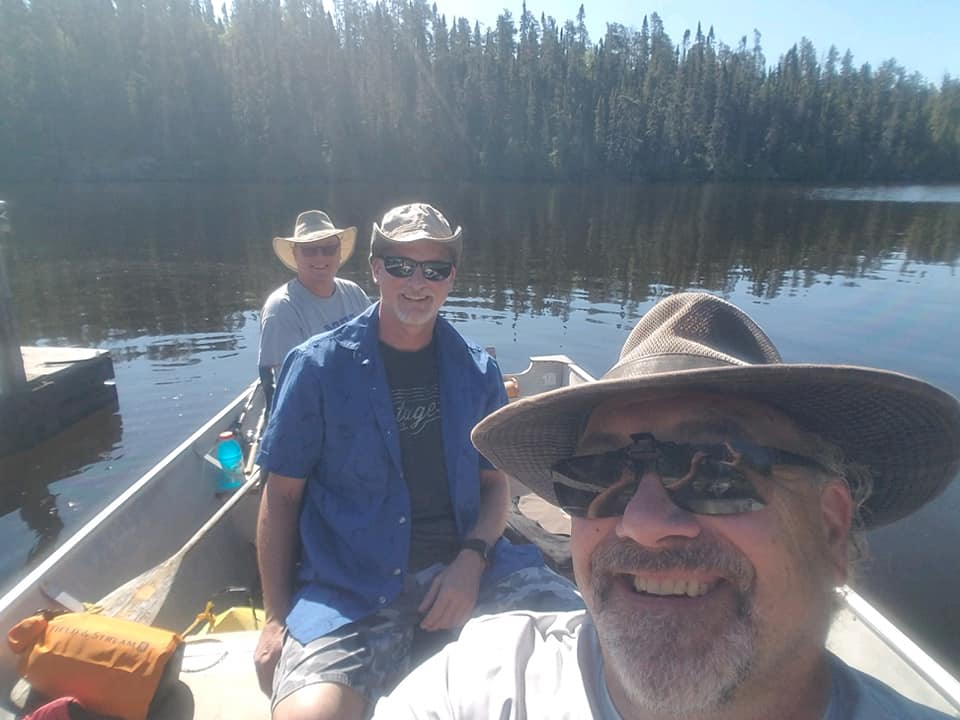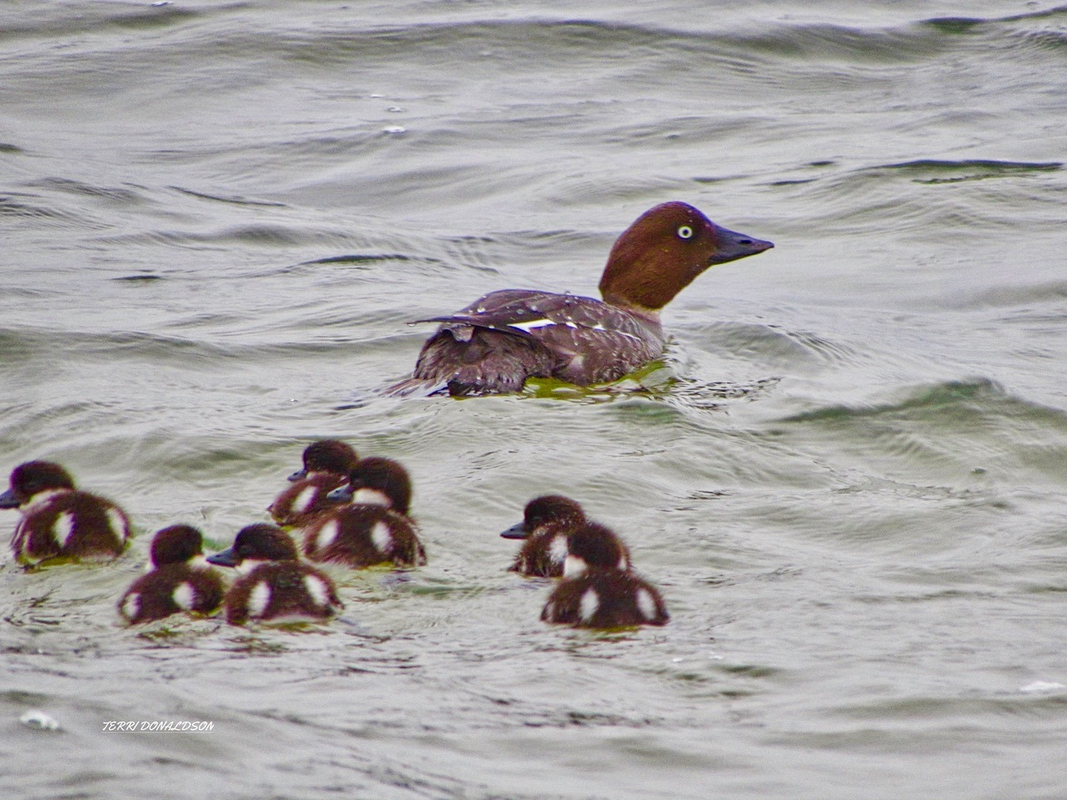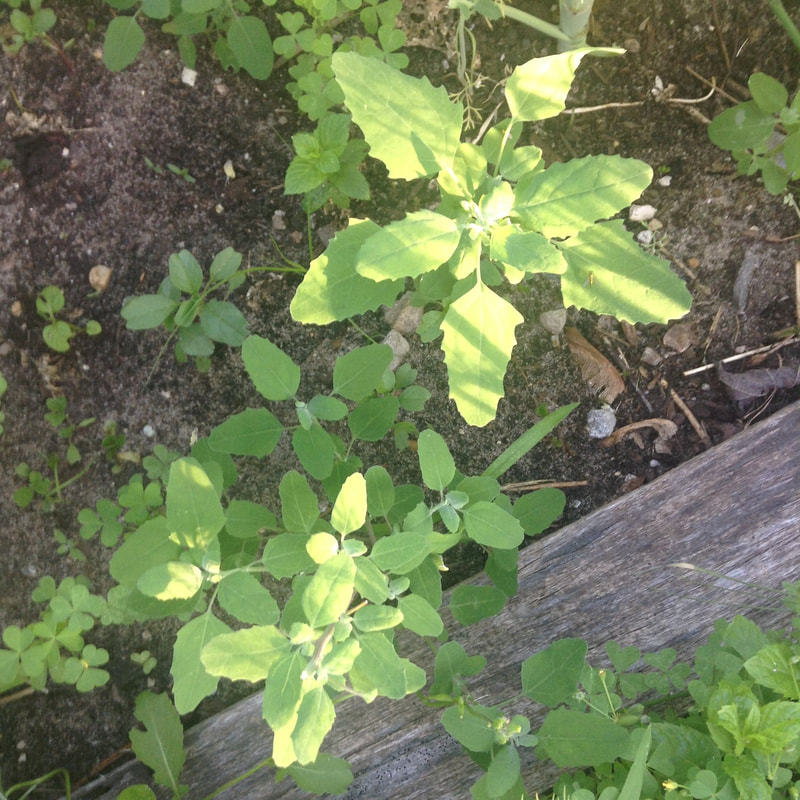|
Photo and story by Donna Iverson
Check around any neighborhood and you will likely find many a deck, porch, or front step with a potted tomato plant. People who no longer garden, for one reason or another, will buy a tomato plant, pot it up and place it in a sunny spot near their doorstep. The potted tomato plant seems to satisfy the need to get your hands in the dirt and watch a small seedling turn into a plant with edible delicious red fruit that tastes better than anything you can buy. This spring, I rescued two tomato plant seedlings from the farmers market and potted them up and gave them a new home on my second-floor apartment deck. Unfortunately, within a few weeks, I learned that when it comes to potted tomato plants, I had a lot to learn and had done pretty much everything wrong. While the tomato is the most popular potted plant, it is also one of the more difficult to grow. But I didn't know that until mid-summer, when my spindly tomato plant was taller than me and looked like a plant from outer space My first mistake, apparently, was planting the seedlings in a too-small container. Tomato plants like to grow in a big pot, the bigger the better. And they don't like to share that container with another tomato plant or any other growing thing. My two seedlings were sharing a too-small container and their roots were competing for nutrients. Tomato also like to be planted deep and have their lower leaves removed. I hadn't done that either. To compensate, I purchased a small bag of potting soil and poured the dirt to top of the container. I was trying to trick my tomatoes into thinking that their stems had been planted in deep soil. Am not sure that worked. Another mistake was that my deck does not provide enough sun, only about four hours worth. Tomatoes require six hours of direct sun and prefer eight hours. I crossed my fingers that the extra hot summer we were having would make up the difference. Not sure that's working either. According to the Farmer's Almanac, tomatoes are incredibly fussy. To quote: "in layman's terms, plants stress when it is too hot or too cold, too much nitrogen and/or too little potassium and calcium, too much or too little water." Despite all these pitfalls, I am doing some things right like watering every day but not over watering, I also apply a steady dose of tomato-specific fertilizer. Potted tomato plants like to be watered in the morning, so I have adjusted my watering schedule accordingly.
0 Comments
"Garden like you're broke"
By Donna Iverson Living along the shores of Muskegon Lake, I heard tell of a Depression Garden being grown at the historic Solnik House in Muskegon. It sounded intriguing so I went for a look. These mostly urban backyard gardens were popular in the 1930s when the depression forced many people to grow their own food to survive. My Dutch maternal grandfather was one of them. During WWII, the depression garden morphed into the more well-known Victory Garden. While we are not in a depression, there is a lot to learn from these back-to-basics gardens that focused on growing staples to feed people. Foods like potatoes, beans, tomatoes, peas, carrots and cabbage. The Depression Garden at the Solnik House is on the south side of the building. Veggies grow in ground-level wooden boxes that likely date back to the 1930s. It is a no-frills garden with the look of simplicity and austerity. I thought about my own community garden bed with its mixture of veggies, herbs and flowers...as well as an ornamental scarlet runner bean. This plant I grow mostly for how it looks with its scarlet flowers that attract hummingbirds. I smiled to think that Jack in the Beanstalk would have loved it. But a depression garden it isn't. Still I was attracted to the depression garden and the lessons it might offer. Such as: 1. Growing your own food as a way to save money and supplement the family income. 2. Insuring that your vegetables are not contaminated by herbicides or pesticides 3. Planting for fresh seasonal produce, lettuce and peas in the spring, tomatoes in the summer, pumpkins in the fall and maybe even a winter crop of collard greens. But there's more than that. We could all use a dose of depression era mentality, according to Kim Slotterback-Hoyun, a northern Michigan gardener. She advises residents to: "garden like you're broke." Plant from seeds if possible. Use what you have to create beds, trellises, and bee houses. Dig out that old shovel and hoe and put some elbow grease into your efforts, forgoing the fancy gardening equipment. And help out your neighbors. Back in the 1930s, vacant lots were turned into relief lots. Food was grown for those who needed it. Much like today's community gardens. Although today, more and more community gardens are putting fences around their beds and warning neighbors, "if you didn't grow it, don't take it." In the community garden that I am a member of, we open the gardens to the public after August when veggies would rot on the vine if not harvested. In summary, depression-era gardens pull us back to basics, growing our own food, using what we have, and helping out our neighbors when possible. Story and photo By Donna Iverson
Ever thought about adding some native plants to your garden as a way to help restore the natural habit of your area which has been largely lost in the past century? If so, a good place to start is by planting a native flower and a good first choice would be purple coneflower. A member of the sunflower family, purple coneflower is native to the eastern United States. Purple coneflower can be found east to New England, west to Iowa, south to the Mississippi valley and north to Ontario, Canada. In addition to being grown in gardens, it has escaped to the wild, and can be found in waste places and woods throughout Michigan. It is at home in formal gardens and wildflower meadows, and tucked along the edge of your vegetable garden. Growing 3 to 5 feet tall in any kind of soil, purple cornflower is easy to grow. This showy perennial doesn't care if it is wet soil or dry, sand or clay, poor or fertile soil. Although it will grow taller if the soil is enriched. Native plants, like the purple coneflower, require less water than cultivated flowers and do not require fertilizer or treatment with herbicides or pesticides. In fact, using herbicides and pesticides would defeat a major reason for planting native plants, which is to feed and provide habitat for pollinators. Adapted to its local environment, it is a magnet to bees, butterflies and birds. Without native plants, bees and butterflies cannot survive. To grow purple coneflower, it is best to buy seedlings as it takes two to three years for this plant to flower from seed. As for medicinal properties, purple coneflower is a member of the genus, Echinacea. Found in the vitamin aisle, Echinacea tablets are widely sold in grocery and drug stores for cold relief. But be careful, there can be allergic reactions and interference with prescription medications. Check with your doctor or pharmacist to be sure it is safe for you. Finally, if the idea of growing native plants really has your attention, check of the National Wildlife Federation website at www.nwf.org. You can enter your zip code, and get a list of the flowers that are native to you exact local. Photos are included and the site is interactive. But whether you decide to grow purple coneflower or not, notice it's beauty the next time you spot it whether hiking or taking a stroll around your neighborhood. Especially enjoy purple coneflowers majestic appearance when it has escaped to the wild. While the larger retail outlets have already started pushing us out of summer and into fall with school supplies replacing sunblock on the shelves and shorts and t-shirts moving to the close out rack to give way to flannel, no foreboding of fall has been more flagrant than ths photo snapped by Jim Maike last week about 9:30pm on 8th Avenue South of White Cloud.
By Terry Grabill I spent some time in northern Ontario last week. It was planned as a fly-in fishing trip for Walleye and Northern Pike but, let’s be honest- I was birding. I was traveling with Tim and Ken, my friends from decades ago, and they like nature but are not particularly excited about birds. The three of us shared a boat on Granite Hill lake for five days and they humored me while I ignored my fishing rod and listened intently to bird songs. I was excited to have the opportunity to hear and see some of my favorite migrants on their “home turf”. As time passed, they too were picking up on sounds and quizzing me on the species making them. And, to my great satisfaction, they started referring to me as “Goober” as much they did Terry. Every year, Andrea and I look forward to our May excursions to migrant hotspots to get our annual glimpse of Cape May, Bay-breasted, and Blackpoll warblers as well as Swainson’s thrush and White-crowned sparrows. They don’t sing much on their migration path: That’s a job left for the breeding grounds. Some of the species that migrate through, especially shorebirds, are bound for the high-arctic. Many, however, are birds that nest in the boreal forests of northern Ontario. The landscape there is breath-taking from the air, with dense (I mean really dense) conifer forests on rocky hills with pristine lakes in each valley. Our float plane flight from White River goes straight north over just such habitat. From the road and from the air, there is lots of evidence that we’re not in West Michigan anymore! We encountered two gray wolves on our drive and a black bear on our last trip. We were advised that if nature calls while we’re fishing, it’s better to land at one of the many islands rather than the mainland shore to avoid a chance encounter with a large carnivore. The birdlife wasn’t as obvious until we were out on the still mornings fishing quietly by Picnic Island. The spruces were alive with birdsong! Northern waterthrush and Connecticut warblers sang constantly. Winter wrens burst out their impossibly long trills. Common ravens made their very un-musical sounds, much the irritation of my partners. I (mostly) ignored their grousing about the “noise” because this BirdGoober was in foreign territory. I was birding by ear to vocalizations I’d heard mostly on CDs, not birds singing to their mates and adversaries just a few yards into the thicket.
Boating around lakes in West Michigan, I see mallards and wood ducks. On Granite Hill Lake I didn’t see a single one of those. Instead, common mergansers (and only females!) abounded. In fact, Tim quickly picked up on IDing those. In the backwater area of a winding river we found common goldeneye. I had read as a boy that these winter visitors to Newaygo nested in the spruce forests of Canada...so why was I surprised to see them? What is a north woods lake without common loons? We have loons at home and their haunting calls epitomize the northern experience. Many of my local fishing lakes have a resident pair that sometimes fledges a baby. On Granite Hill Lake, however, loons are different. These were not pairs and I didn’t see. any with young. They were in groups of five to ten and were mostly silent as they fed together far from shore. On our visit to Granite Hill two years ago, I counted a string of more than fifty as we motored to the west end of the lake! I think I won’t look at migrants quite the same way after visiting their breeding grounds. These little fighters stop only briefly on their journey, and I’m glad I got to see their summer destination. For BirdGoober, I’m Terry Grabill Photo and story by Donna Iverson
I love Lambsquarters. I know love is a strong word for an edible weed, but it's appearance every spring in my garden bed before the regular veggies are even planted, makes it a special treat. And while I enjoy growing vegetables, herbs and native flowers, I am at heart a forager. And a defender of weeds, especially the edible kind. Which most of them are. Suspect my foraging tendencies were inherited from my grandmother who used to track down edible wild food in the fields behind her Whitehall farm as I trailed along behind. We collected wild berries along the path leading to the orchard, and sassafras leaves and asparagus hiding in the tall grass. To me, hunting down wild edibles was a lot more exciting then picking beans in the large kitchen garden next to the chicken coop. Sometimes, we would encounter a snake, which would freeze us in our tracks, even though garden snakes are not poisonous. While edible weeds are all of interest, Lambsquarter is my favorite. For one thing, it is easily identified and distinctive enough not to be confused with any other plants. It is a small dusty looking plant with alternate leaves, shaped like a goosefoot. Secondly, this summer annual self seeds and appears without any effort by the gardener, although you can buy packets of Lambsquarters seeds and plant it as cover crop to enrich the soil. Third, it tastes good, and has been compared to spinach. Like spinach, you can toss it in a salad, cook it like a vegetable, or nibble on it as you weed the garden beds Finally, it is a healthy addition to your diet, high in calcium, iron, and Vitamins A, B, and C. It is also anti-inflammatory. Lambsquarters was once thought to be a native of Europe, but recent archeological evidence places it in North and South America as far back as 6500 BC. Native Americans were especially fond of Lambsquarters' black seeds, which can be ground into a tasty flour, which we call quinoa. A little research on the Internet, turned up recipes for Lambsquarters tea , mouth wash, soap and shampoo, all made from its roots. So next time, don't be so quick to pull out and discard those garden weeds. You may have discovered this special little plant called Lambsquarters, and find you like the taste as much as I do. |
Archives
April 2024
Categories |








 RSS Feed
RSS Feed